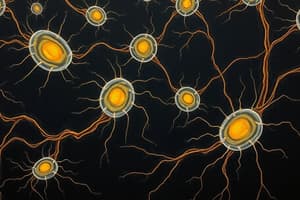Podcast
Questions and Answers
What is the primary function of palisade cells?
What is the primary function of palisade cells?
- Absorbing sunlight for photosynthesis (correct)
- Providing structural support
- Facilitating nutrient absorption
- Transporting water
The xylem cells are responsible for transporting nutrients throughout the plant.
The xylem cells are responsible for transporting nutrients throughout the plant.
False (B)
What adaptation allows xylem cells to efficiently transport water?
What adaptation allows xylem cells to efficiently transport water?
Xylem cells are long, thin hollow tubes with no end walls, allowing uninterrupted flow of water.
Specialised cells differ from generalised cells in that they have a more complex structure and are adapted to perform specific __________.
Specialised cells differ from generalised cells in that they have a more complex structure and are adapted to perform specific __________.
Match the following cells with their functions:
Match the following cells with their functions:
What is the primary function of muscle cells?
What is the primary function of muscle cells?
Sperm cells have a large size with lots of cytoplasm.
Sperm cells have a large size with lots of cytoplasm.
What are the two types of gametes?
What are the two types of gametes?
The __________ cell is specialized for making food in plants.
The __________ cell is specialized for making food in plants.
What adaptation allows neurons to conduct impulses effectively?
What adaptation allows neurons to conduct impulses effectively?
Match the following cells with their primary functions:
Match the following cells with their primary functions:
Root hair cells are specialized to store food for the plant.
Root hair cells are specialized to store food for the plant.
What part of the sperm cell is responsible for providing energy?
What part of the sperm cell is responsible for providing energy?
What is the primary function of red blood cells?
What is the primary function of red blood cells?
White blood cells can change shape to engulf bacteria.
White blood cells can change shape to engulf bacteria.
What is the significance of the biconcave shape of red blood cells?
What is the significance of the biconcave shape of red blood cells?
Ciliated epithelial cells are found in the ______ and bronchi.
Ciliated epithelial cells are found in the ______ and bronchi.
Match the specialized cell with its function:
Match the specialized cell with its function:
Which specialized cell has no nucleus to maximize space for hemoglobin?
Which specialized cell has no nucleus to maximize space for hemoglobin?
Smoking may enhance the function of ciliated epithelial cells.
Smoking may enhance the function of ciliated epithelial cells.
Name one adaptation of ciliated epithelial cells.
Name one adaptation of ciliated epithelial cells.
Flashcards are hidden until you start studying
Study Notes
Specialized Cells Overview
- Specialized cells have specific structures and functions tailored for particular tasks in the body.
- Examples include muscle cells, nerve cells, red blood cells, and gametes.
Importance of Specialized Cells
- Specialized cells enable efficient execution of jobs in animals and plants.
- Adaptations in structure are crucial for their functions.
Animal Specialized Cells
-
Red Blood Cells
- Contain hemoglobin, which gives them their red color.
- Transport oxygen from lungs to body cells for energy production via respiration.
- Biconcave shape increases surface area for oxygen absorption; no nucleus allows more room for hemoglobin.
-
White Blood Cells
- Produce antibodies to neutralize bacteria.
- Can change shape due to the flexible nucleus, enabling them to engulf pathogens.
-
Ciliated Epithelial Cells
- Trap dust and bacteria in the airways, providing respiratory protection.
- Found in the trachea and bronchi; impaired by smoking.
-
Muscle Cells
- Allow body movement and are found in muscular systems.
- Long structure with protein bands; arranged in fibers to facilitate contraction.
-
Nerve Cells (Neurons)
- Transmit impulses for body functions; essential for coordination.
- Long, branched structure supports long-distance signal transmission.
-
Gametes (Sex Cells)
-
Include sperm and ovum, crucial for reproduction.
-
Sperm Cell
- Male reproductive cell; equipped with tail for movement.
- Contains head for enzyme production to penetrate ovum; neck full of mitochondria for energy.
-
Ovum (Egg Cell)
- Female reproductive cell, larger than sperm, rich in cytoplasm.
- Provides nutrition for the developing embryo and contains female genetic material.
-
Plant Specialized Cells
-
Root Hair Cells
- Increase surface area for absorption of water and minerals from soil.
- Found at the tips of roots, facilitating plant nourishment.
-
Palisade Cells
- Found in leaves; crucial for photosynthesis by capturing sunlight.
- Large surface area and numerous chloroplasts optimize light absorption.
-
Xylem Cells/Vessels
- Transport water from roots to other parts of the plant.
- Long, hollow structure allows for continuous water flow; lacks end walls and cytoplasm for efficiency.
Comparison with Generalized Cells
- Generalized cells (e.g., skin cells) have simpler structures and functions.
- Specialized cells possess more complex structures, enabling them to perform unique roles.
Adaptability of Specialized Cells
- Structure and function of specialized cells can evolve over time due to aging or disease.
- For instance, muscle cells may deteriorate with age, and nerve cells can be affected by conditions like Alzheimer’s.
Studying That Suits You
Use AI to generate personalized quizzes and flashcards to suit your learning preferences.




